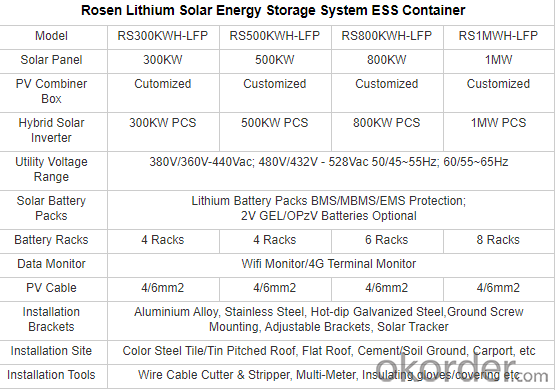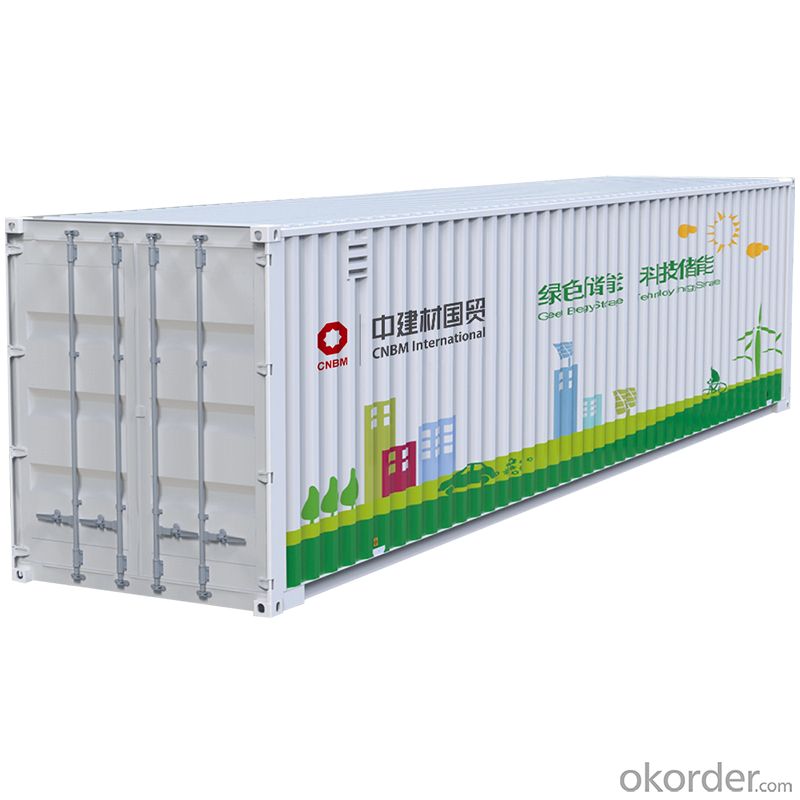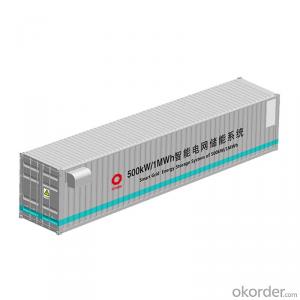ESS Solar Energy Storage System 500kw 1MWH With Lifepo4 Battery Container
- Loading Port:
- Shanghai
- Payment Terms:
- TT OR LC
- Min Order Qty:
- 1 unit
- Supply Capability:
- 10 unit/month
OKorder Service Pledge
OKorder Financial Service
You Might Also Like
Item specifice

Solar Panels
Mono/Poly/felxible/black etc all types Panels;
High efficiency power up to 450W/ 550W/600W Half Cell/Bifacial Solar PV Modules;
All certificates listed with more than 30years life and warranty
PID Resistant,High salt and ammonia resistance;
Hybrid Energy Storage Inverter
Automatic Switch to charge loads, batteries or from Grid backup with priority setting function; Lithium Battery and GEL storage battery compatible with almost all types of inverters;Comprehensive WIFI monitor for electricity production and consumption data, to check your investment payment on time;
Solar Lithium/GEL Battery Packs
Lithium and GEL Storage Batteries Optional;
100Ah/150Ah/200Ah, with 100kwh/300kwh/500kwh capacity;
BMS Communication matched with almost all types of hybrid energy inverters;
Installation is convenient with cable, rack etc Accessories ready in package.


- Q:How do solar energy systems impact the reduction of nuclear power reliance?
- Solar energy systems can have a significant impact on reducing reliance on nuclear power by providing a clean and renewable alternative. As solar power becomes more accessible and affordable, it can help decrease the need for nuclear power plants, which often pose environmental and safety concerns. Additionally, solar energy systems can decentralize power generation, allowing individuals and communities to generate their own electricity and reduce their dependence on centralized nuclear facilities.
- Q:Are there any limitations to using solar energy for powering vehicles?
- Yes, there are some limitations to using solar energy for powering vehicles. The main limitation is the limited amount of energy that can be harvested from the sun, especially when compared to the energy density of conventional fossil fuels. Additionally, solar panels require a large surface area for installation, which could be a challenge for vehicles with limited space. Moreover, solar energy is intermittent, meaning it is not available during the night or in cloudy weather, which might affect the reliability and range of solar-powered vehicles. Finally, the cost of solar panels and their relatively low efficiency in converting sunlight to electricity also pose challenges to widespread adoption. Nonetheless, advancements in technology and the development of energy storage solutions are helping to overcome some of these limitations and make solar-powered vehicles more viable.
- Q:How does shading affect the performance of solar energy systems?
- Shading has a significant impact on the performance of solar energy systems as it reduces the amount of sunlight reaching the solar panels, thereby reducing their efficiency in generating electricity. Even partial shading on a small portion of the panel can cause a significant drop in the system's output. Therefore, it is crucial to minimize shading, especially during peak sunlight hours, to maximize the performance and overall energy production of solar systems.
- Q:Can solar energy systems be installed in areas with high snowfall?
- Yes, solar energy systems can be installed in areas with high snowfall. While snow can temporarily reduce the efficiency of solar panels by covering them, it is still possible to generate electricity from solar energy during winter months. Additionally, advancements in technology have led to the development of snow-shedding designs and tilt systems that can help minimize snow accumulation on panels. Regular maintenance and cleaning can further optimize the system's performance in snowy conditions.
- Q:What are the advantages of solar energy systems?
- Solar energy systems offer several benefits. To begin with, solar energy is an endless source of power, relying on the sun's continuous existence. This stands in stark contrast to finite fossil fuels, which are depleting rapidly. Furthermore, solar energy is environmentally conscious. Unlike fossil fuels, solar energy systems do not release harmful greenhouse gases or pollutants that contribute to climate change and air pollution. This makes solar energy a clean and sustainable alternative that aids in reducing our carbon footprint and countering the adverse effects of global warming. Moreover, solar energy systems can significantly decrease electricity expenses. Once the initial investment in solar panels is made, the cost of harnessing solar energy remains relatively low. Solar energy is essentially free, with the only expenses being equipment maintenance and occasional repairs. This can result in substantial long-term savings on energy bills, especially considering the continuous rise in traditional electricity costs. Additionally, solar energy systems promote energy independence. By generating your own electricity, you become less reliant on utility companies and the fluctuating prices of fossil fuels. This independence enhances energy security, as solar energy systems are not susceptible to supply disruptions or price fluctuations caused by geopolitical tensions or natural disasters. Lastly, the installation of solar energy systems stimulates local economies and job creation. The solar industry has experienced significant growth, leading to the creation of numerous jobs in manufacturing, installation, and maintenance. This not only boosts the economy but also provides employment opportunities in a rapidly expanding sector. In conclusion, the benefits of solar energy systems are manifold. From being a renewable and environmentally friendly power source to reducing electricity expenses, providing energy independence, and generating jobs, solar energy proves to be a viable and sustainable solution for our energy needs.
- Q:Can solar energy systems be used for powering drones?
- Yes, solar energy systems can be used for powering drones. Solar panels can be installed on the surface of drones to capture sunlight and convert it into electrical energy, which can then be used to power the drone's motors and other electronic components. This allows drones to have extended flight times and reduces the dependence on traditional battery power.
- Q:Can solar energy systems be used for powering mining operations?
- Yes, solar energy systems can be used for powering mining operations. Solar panels can be installed on-site to generate electricity, which can then be used to power various mining equipment and operations. This can help reduce reliance on traditional energy sources, lower operating costs, and minimize the environmental impact of mining activities.
- Q:Can solar energy systems be used for powering electric vehicle autonomous driving systems?
- Solar energy systems are capable of powering electric vehicle autonomous driving systems. The vehicle's roof can accommodate solar panels, which capture sunlight and convert it into electricity. This electricity is then utilized to fuel the autonomous driving systems, including sensors, cameras, and computer systems that enable the vehicle to navigate and make independent decisions. By harnessing solar energy, the vehicle can decrease its dependence on fossil fuels and operate with decreased carbon emissions. Nevertheless, it's crucial to acknowledge that solar panels may not generate sufficient power to solely sustain the entire autonomous driving system, especially during extended periods or when the weather is cloudy. In such instances, the vehicle may still require grid charging or alternative charging approaches.
- Q:What are the key components of a solar energy system?
- The key components of a solar energy system include solar panels, an inverter, a mounting system, batteries (optional), and a monitoring system.
- Q:Can solar energy systems be used in commercial agriculture?
- Yes, solar energy systems can be used in commercial agriculture. They can provide a sustainable and cost-effective solution for powering various agricultural operations such as irrigation systems, greenhouse heating, and livestock facilities. Solar panels can be installed on rooftops or as ground-mounted systems in farms to harness the sun's energy and generate electricity for on-site use. This helps reduce reliance on traditional energy sources, lowers operational costs, and promotes environmentally friendly practices in commercial agriculture.
1. Manufacturer Overview |
|
|---|---|
| Location | |
| Year Established | |
| Annual Output Value | |
| Main Markets | |
| Company Certifications | |
2. Manufacturer Certificates |
|
|---|---|
| a) Certification Name | |
| Range | |
| Reference | |
| Validity Period | |
3. Manufacturer Capability |
|
|---|---|
| a)Trade Capacity | |
| Nearest Port | |
| Export Percentage | |
| No.of Employees in Trade Department | |
| Language Spoken: | |
| b)Factory Information | |
| Factory Size: | |
| No. of Production Lines | |
| Contract Manufacturing | |
| Product Price Range | |
Send your message to us
ESS Solar Energy Storage System 500kw 1MWH With Lifepo4 Battery Container
- Loading Port:
- Shanghai
- Payment Terms:
- TT OR LC
- Min Order Qty:
- 1 unit
- Supply Capability:
- 10 unit/month
OKorder Service Pledge
OKorder Financial Service
Similar products
New products
Hot products
Hot Searches
Related keywords





























